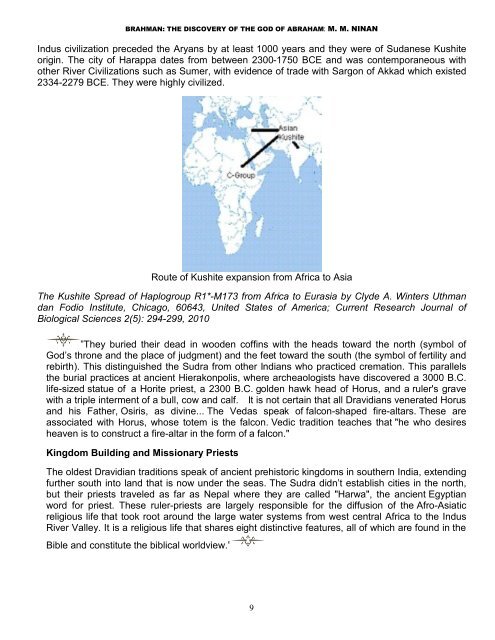You also want an ePaper? Increase the reach of your titles
YUMPU automatically turns print PDFs into web optimized ePapers that Google loves.
BRAHMAN: THE DISCOVERY OF THE GOD OF ABRAHAM: M. M. NINAN<br />
Indus civilization preceded the Aryans by at least 1000 years and they were of Sudanese Kushite<br />
origin. The city of Harappa dates from between 2300-1750 BCE and was contemporaneous with<br />
other River Civilizations such as Sumer, with evidence of trade with Sargon of Akkad which existed<br />
2334-2279 BCE. They were highly civilized.<br />
Route of Kushite expansion from Africa to Asia<br />
The Kushite Spread of Haplogroup R1*-M173 from Africa to Eurasia by Clyde A. Winters Uthman<br />
dan Fodio Institute, Chicago, 60643, United States of America; Current Research Journal of<br />
Biological Sciences 2(5): 294-299, 2010<br />
”They buried their dead in wooden coffins with the heads toward the north (symbol of<br />
God’s throne and the place of judgment) and the feet toward the south (the symbol of fertility and<br />
rebirth). This distinguished the Sudra from other Indians who practiced cremation. This parallels<br />
the burial practices at ancient Hierakonpolis, where archeaologists have discovered a 3000 B.C.<br />
life-sized statue of a Horite priest, a 2300 B.C. golden hawk head of Horus, and a ruler's grave<br />
with a triple interment of a bull, cow and calf. It is not certain that all Dravidians venerated Horus<br />
and his Father, Osiris, as divine... The Vedas speak of falcon-shaped fire-altars. These are<br />
associated with Horus, whose totem is the falcon. Vedic tradition teaches that "he who desires<br />
heaven is to construct a fire-altar in the form of a falcon."<br />
Kingdom Building and Missionary Priests<br />
The oldest Dravidian traditions speak of ancient prehistoric kingdoms in southern India, extending<br />
further south into land that is now under the seas. The Sudra didn’t establish cities in the north,<br />
but their priests traveled as far as Nepal where they are called "Harwa", the ancient Egyptian<br />
word for priest. These ruler-priests are largely responsible for the diffusion of the Afro-Asiatic<br />
religious life that took root around the large water systems from west central Africa to the Indus<br />
River Valley. It is a religious life that shares eight distinctive features, all of which are found in the<br />
Bible and constitute the biblical worldview.”<br />
9


















